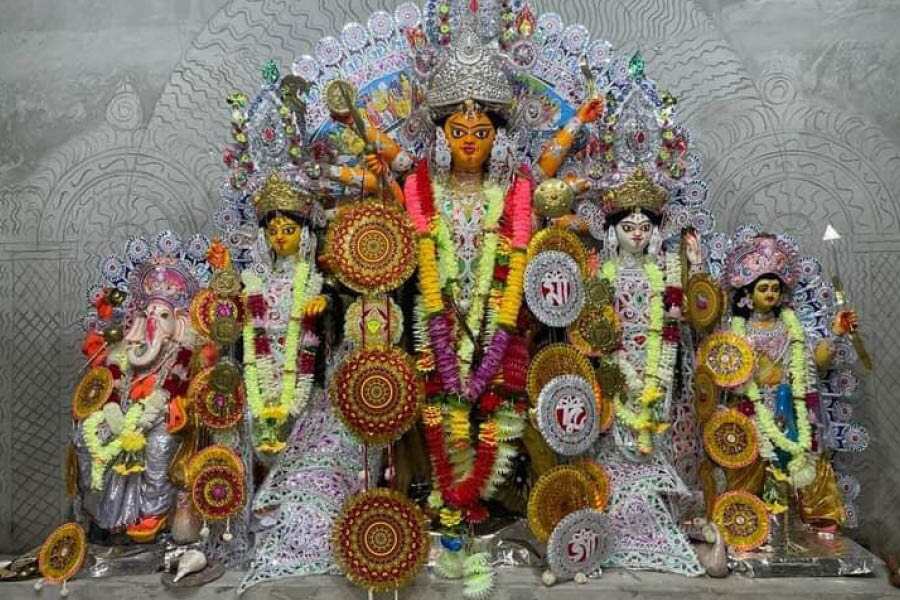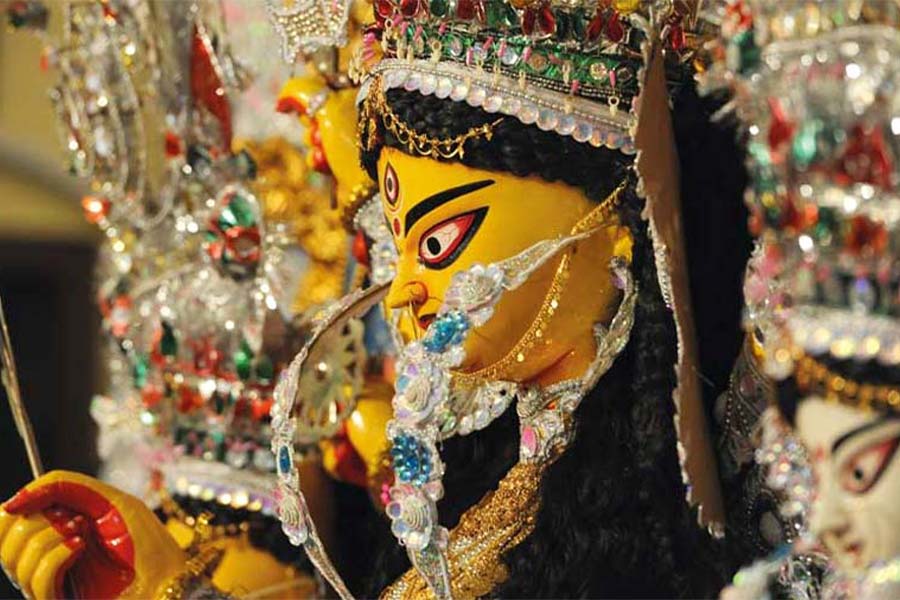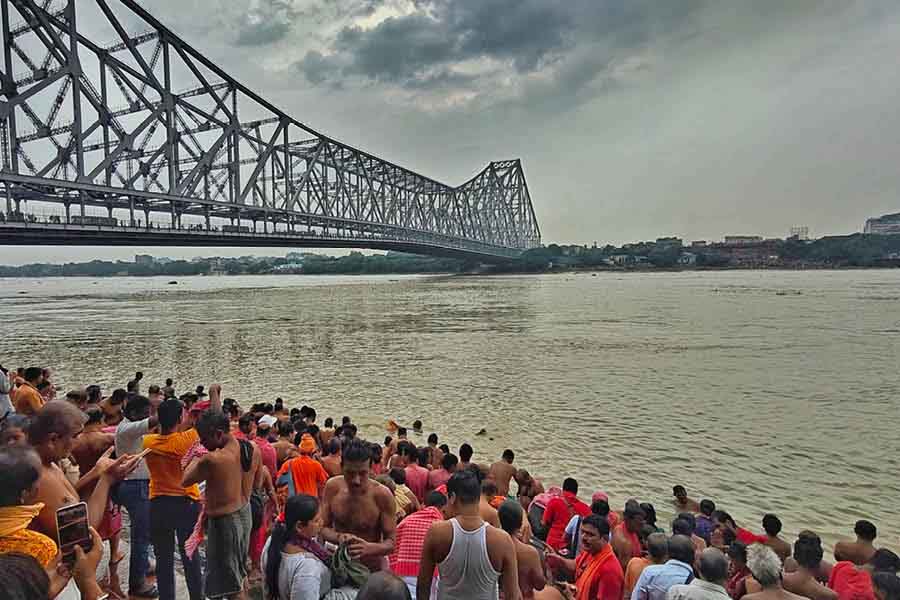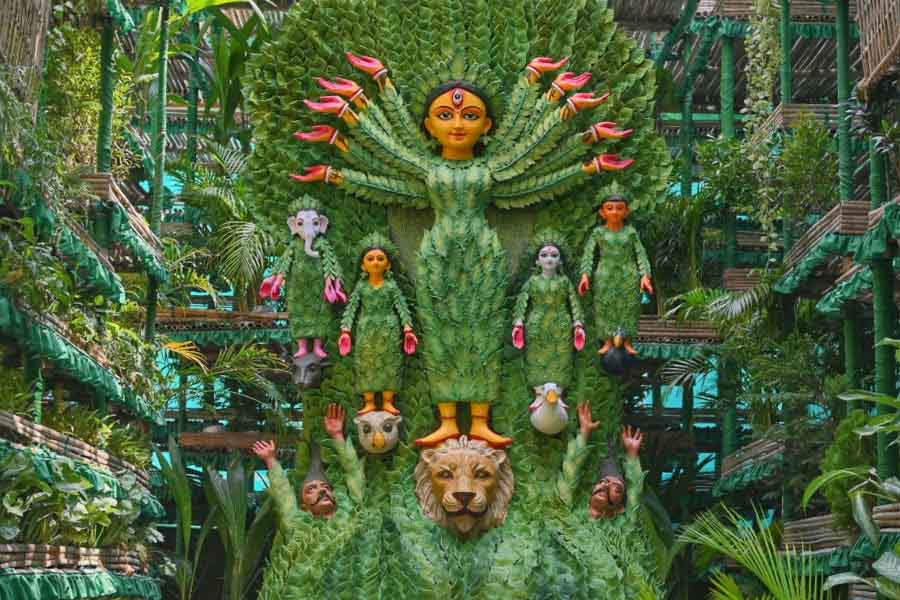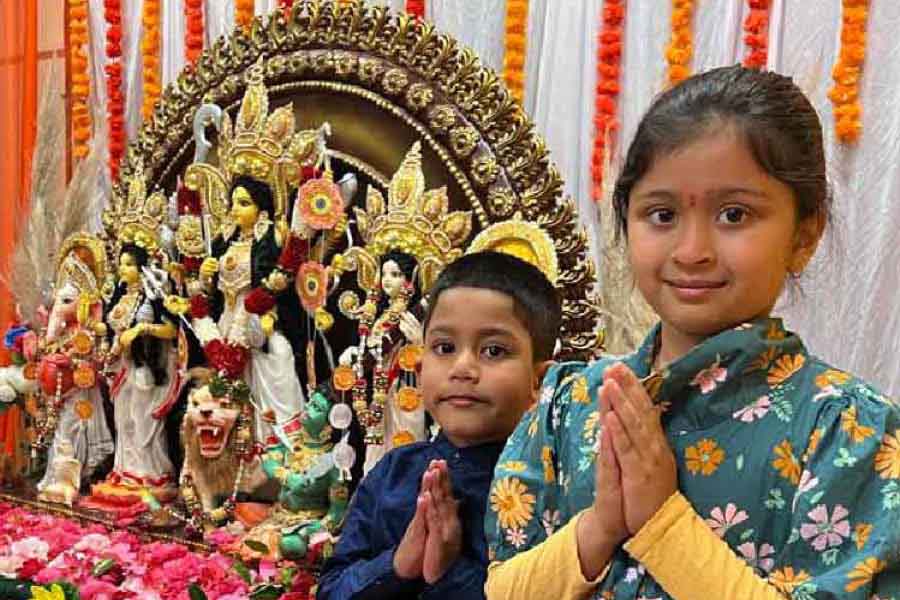More than 300 years ago, a small village named Soyai in Burdwan district of Bengal was a booming centre of Sanskrit learning and home to 22 schools. Legendary Sanskrit scholar Hati Vidyalankar was born there and gained primary education from her father.
A young student named Basudev arrived in Soyai from Bakalsa village of Katwa’s Faridpur to learn Sanskrit and other sacred texts. On completion of his education, he settled there by marrying a daughter of the local Chattaraj family.
It was the time when the Mughals under Aurangzeb were still ruling vast expanses from Delhi and Hindus were fast realising the need to hold on to their religion more to protect their cultural heritage.
Around 1692, Basudev, who was into agriculture then, suddenly announced that he had been ordered by Devi Durga to bring her to Soyai from his ancestral home of Bakalsa, where Durga puja was an age-old tradition of his family.
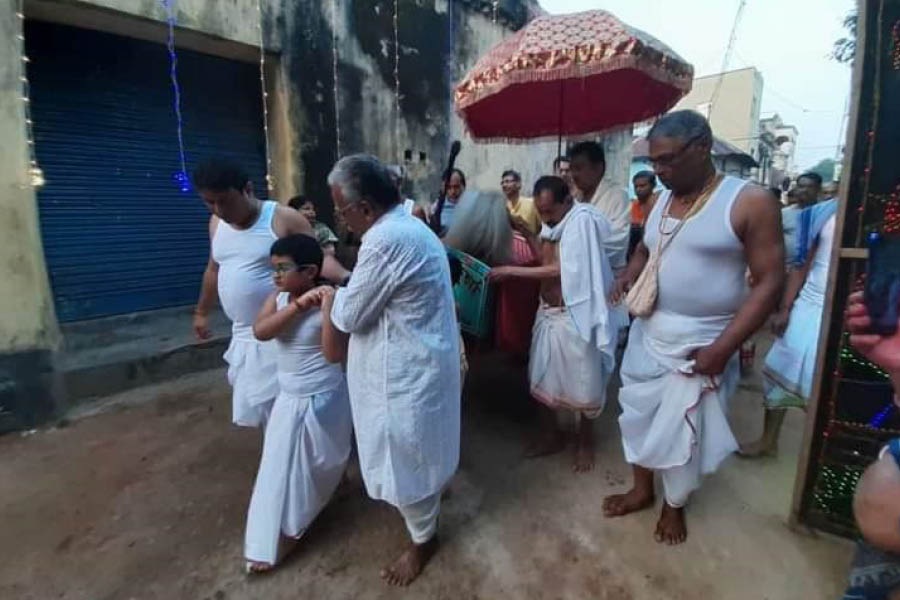
The ‘nabapatrika’ is taken out to bathe in a decorated ‘palki’ (palanquin) carried by the young boys of the family
Basudev soon left for Bakalsa with three of his sons — Bhavani, Ram Narayan and Ramkinkar — to bring the bamboo structure of Durga to Soyai. Legend has it that while bringing the structure from Bakalsa to Soyai, his path was blocked by two sentries of the Burdwan royal family and he was asked to let a royal caravan pass. Basudev refused to obey and reasoned that he was bringing Durga home and it would be a dishonour to the deity if he stopped. This resulted in a heated argument when Krishnaram Rai, the king of the Burdwan between 1675 and 1696, arrived at the spot.
Impressed by Basudev’s courage and dedication to Durga, the king not only allowed the deity to pass but also gifted a large piece of land to establish a Durga temple in the village. Such was the beginning of the 332-year-old Durgotsav of the Mukherjee family of Soyai, a village just 16km away from Durgapur.
Today, after more than three centuries, the family has many branches but many of them continue to come together every year to celebrate their family Durgotsav, which is one of the oldest.
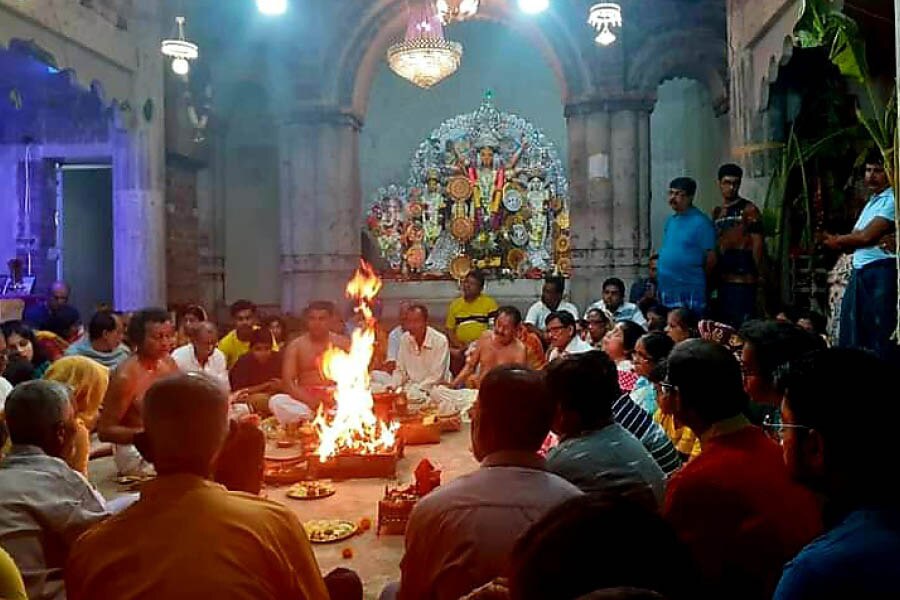
The family allows everyone to participate in the puja. Widows are allowed to carry out all puja tasks but they do not take part in the baron at the time of immersion
The idol is made in the traditional ekchala format, where the face of Durga is made bigger than the faces of Lakshmi, Saraswati, Kartik and Ganesh. The present idol artist has followed almost the same image of the idol over the centuries.
The puja starts on Rath Yatra by worshipping the incomplete structure of the goddess.
After the bodhon (ritualistic welcome) is performed on Sashthi, the festive mood takes a new height on the morning of Maha Saptami when nabapatrika is taken out to bathe in a decorated palki (palanquin) carried by the young boys of the family only before their thread ceremony.
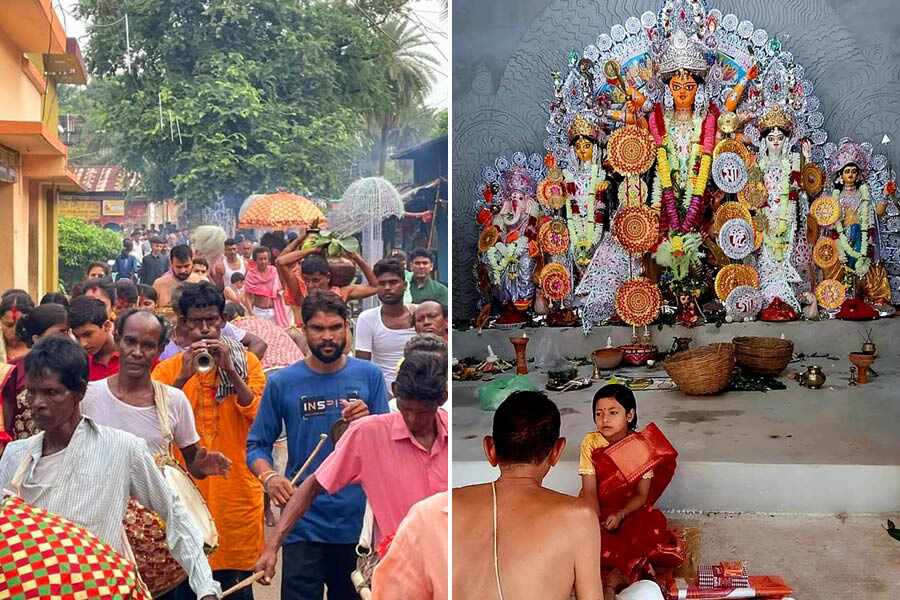
On Saptami, Ashtami and Navami, Durga is offered seven, eight and nine different plates of food items, respectively
The nabapatrika is taken for a bath to a pond named Tantpukur, which is next to Someshwar Mahadevtala, in a procession accompanied by the beats of dhak and tune of shehnai.
Durga is offered a huge spread of food on all three days. On Saptami, Ashtami and Navami, Durga is offered seven, eight and nine different plates of food items, respectively. At the time of sandhi puja, Durga is offered ‘Raas naivaidya’. It is a special offering created in the shape of a grain vessel made of six bags of ataap rice and various kinds of seasonal fruits.
This offering signifies the agricultural tradition of the family. What’s important to note is that Durga in Bengal was initially worshipped as the goddess of agriculture.
The family allows everyone to participate in the puja. Widows are allowed to carry out all puja tasks but they do not take part in the baron at the time of immersion.
The puja of the Mukherjees is conducted according to Shakta customs and it follows age-old traditions, including animal sacrifice. Offering blood to the Devi is considered one of the prime parts of this puja through no non-vegetarian food as bhog is offered to her.
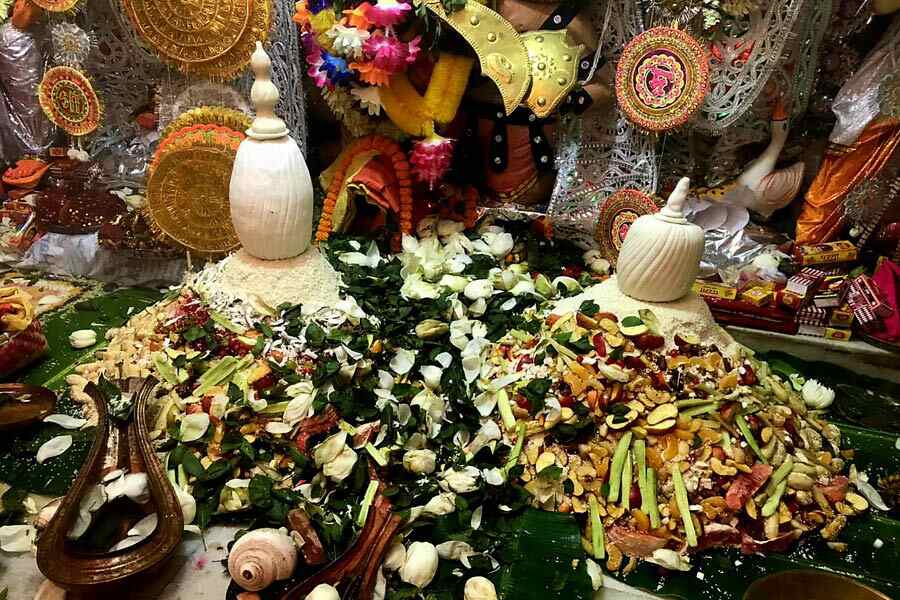
The family is proud that the sacred text which is recited during Durga Puja was written by one of their family members
On both Saptami and Ashtami, a goat is sacrificed before the Devi, while on Navami, a lamb, a goat and a buffalo are sacrificed along with fruits and vegetables. Earlier, after sacrificing the buffalo, the beheaded body of the animal would be gifted to tribals residing near the village. Nowadays, the body is buried. However, till now, the meat of the sacrificed lamb and goat are served the guests who come to participate in the puja.
On Navami, immediately after all animal sacrifices are done, all male members with the patch of the sacred blood on their forehead dance in front of the deity to the song “O Maa Digambari Nacho”. At the end of Shiva yajna on Navami, the entire Mukherjee family descends on the streets and goes around the village dancing and singing.
This procession ends at Jantatala, a place where it is believed once a sacred man used to live. There in front of the villagers, another sacrificial goat is sacrificed to signify the power of the Shakta cult of the village.
This over enthusiastic celebration of animal sacrifices invited a lot of disputes and challenges to the family since the colonial era.
The British Raj twice issued orders to stop the over celebration of animal sacrifice in the puja — one order was issued in 1875 and another was issued in 1916. Surprisingly enough that in both the cases, the family managed to get the order overruled, showing enough logic mingled with religious sentiments of common people. In 1977-78 during the rule of Janata Party under Morarjee Desai asked the local district magistrate to stop the animal sacrifice and all related celebrations. However, this time as well, the family were successful in protecting their ritual.
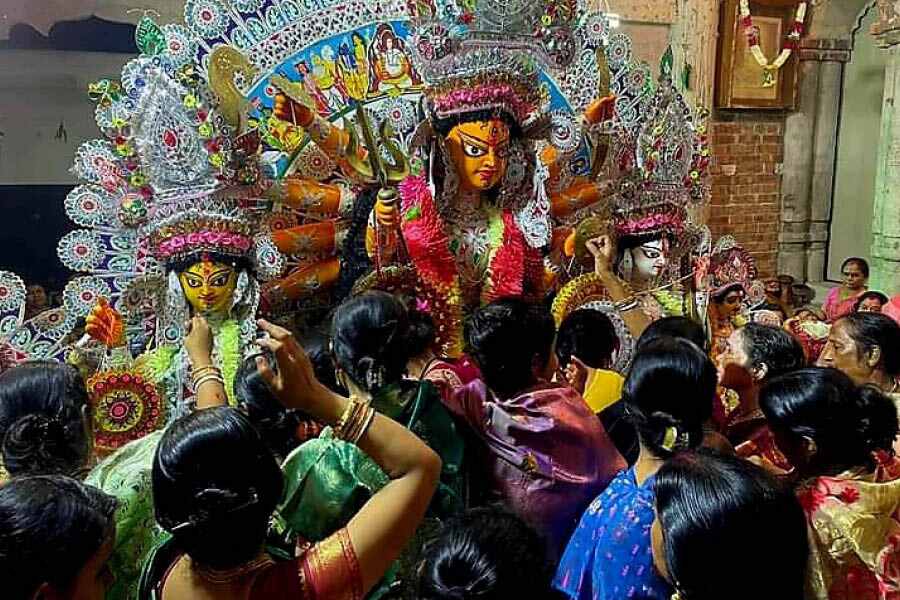
Immersion takes place on Dashami and immediately after the idol is thrown into the water, its structure is salvaged for reuse
The family is proud that the sacred text which is recited during Durga Puja was written by one of their family members, Bhabani Mukherjee, the eldest son of Basudev Mukherjee.
Immersion takes place on Dashami and immediately after the idol is thrown into the water, its structure is salvaged for reuse.
Biswarup Mukherjee and Krishna Prasad Mukherjee, two active members of the family, who take initiative of organising the puja at present, are immensely proud of their family heritage.
“Animal sacrifice is not considered here as a cruelty shown to animals, rather it is a symbolism of overcoming lust and desire,” Biswarup signs off with a smile.
